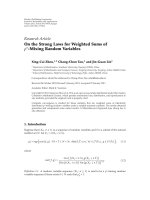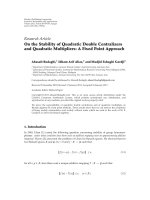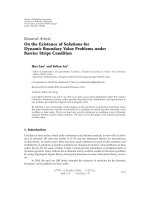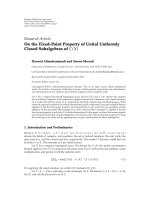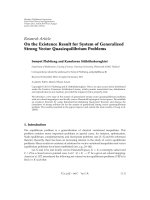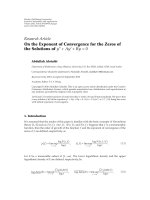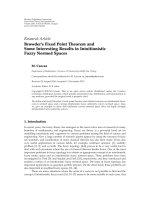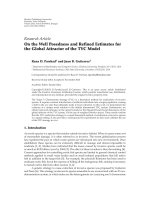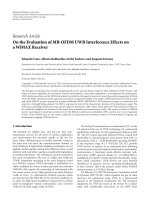Báo cáo hóa học: " Research Article On the Connection between Kronecker and Hadamard Convolution Products of Matrices and Some Applications" pptx
Bạn đang xem bản rút gọn của tài liệu. Xem và tải ngay bản đầy đủ của tài liệu tại đây (481.54 KB, 10 trang )
Hindawi Publishing Corporation
Journal of Inequalities and Applications
Volume 2009, Article ID 736243, 10 pages
doi:10.1155/2009/736243
Research Article
On the Connection between Kronecker and
Hadamard Convolution Products of Matrices
and Some Applications
Adem Kılıc¸man
1
and Zeyad Al Zhour
2
1
Department of Mathematics, Institute for Mathematical Research, University Putra Malaysia,
43400 UPM Serdang, Selangor, Malaysia
2
Department of Mathematics, Zarqa Private University, P.O. Box 2000, Zarqa 1311, Jordan
Correspondence should be addressed to Adem Kılıc¸man,
Received 16 April 2009; Revised 29 June 2009; Accepted 14 July 2009
Recommended by Martin J. Bohner
We are concerned with Kronecker and Hadamard convolution products and present some
important connections between these two products. Further we establish some attractive
inequalities for Hadamard convolution product. It is also proved that the results can be extended
to the finite number of matrices, and some basic properties of matrix convolution products are also
derived.
Copyright q 2009 A. Kılıc¸man and Z. Al Zhour. This is an open access article distributed under
the Creative Commons Attribution License, which permits unrestricted use, distribution, and
reproduction in any medium, provided the original work is properly cited.
1. Introduction
There has been renewed interest in the Convolution Product of matrix functions that is very
useful in some applications; see for example 1–6. The importance of this product stems
from the fact that it arises naturally in divers areas of mathematics. In fact, the convolution
product plays very important role in system theory, control theory, stability theory, and,
other fields of pure and applied mathematics. Further the technique has been successfully
applied in various fields of matrix algebra such as, in matrix equations, matrix differential
equations, matrix inequalities, and many other subjects; for details see 1, 7, 8. For example,
in 2, Nikolaos established some inequalities involving convolution product of matrices
and presented a new method to obtain closed form solutions of transition probabilities
and dependability measures and then solved the renewal matrix equation by using the
convolution product of matrices. In 6, Sumita established the matrix Laguerre transform
to calculate matrix convolutions and evaluated a matrix renewal function, similarly, in 9,
Boshnakov showed that the entries of the autocovariances matrix function can be expressed
in terms of the Kronecker convolution product. Recently in 1, Kilic¸man and Al Zhour
2 Journal of Inequalities and Applications
presented the iterative solution of such coupled matrix equations based on the Kronecker
convolution structures.
In this paper, we consider Kronecker and Hadamard convolution products for
matrices and define the so-called Dirac identity matrix D
n
t which behaves like a group
identity element under the convolution matrix operation. Further, we present some results
which includes matrix equalities as well as inequalities related to these products and give
attractive application to the inequalities that involves Hadamard convolution product. Some
special cases of this application are also considered. First of all, we need the following
notations. The notation M
I
m,n
is the set of all m × n absolutely integrable matrices for all
t ≥ 0, and if m n, we write M
I
n
instead of M
I
m,n
. The notation A
T
t is the transpose of
matrix function At. The notations δt and D
n
tδtI
n
are the Dirac delta function and
Dirac identity matrix, respectively; here, the notation I
n
is the scalar identity matrix of order
n×n. The notations At ∗ Bt, At Bt,andAt•Bt are convolution product, Kronecker
convolution product and Hadamard convolution product of matrix functions At and Bt,
respectively.
2. Matrix Convolution Products and Some Properties
In this section, we introduce Kronecker and Hadamard convolution products of matrices,
obtain some new results, and establish connections between these products that will be useful
in some applications.
Definition 2.1. Let Atf
ij
t ∈ M
I
m,n
, Btg
jr
t ∈ M
I
n,p
,andCtz
ij
t ∈ M
I
m,n
.
The convolution, Kronecker convolution and Hadamard convolution products are matrix
functions defined for t ≥ 0 as follows whenever the integral is defined.
i Convolution product
A
t
∗ B
t
h
ir
t
with h
ir
t
n
k1
t
0
f
ik
t − x
g
kr
x
dx
n
k1
f
ik
t
∗ g
kr
t
.
2.1
ii Kronecker convolution product
A
t
B
t
f
ij
t
∗ B
t
ij
. 2.2
iii Hadamard convolution product
A
t
•C
t
f
ij
t
∗ z
ij
t
ij
. 2.3
where f
ij
t ∗ Bt is the ijth submatrix of order n × p;thusAt Bt is of order mn × np,
At ∗ Bt is of order m × p, and similarly, the product At•Ct is of order m × n.
The following two theorems are easily proved by using the definition of the
convolution product and Kronecker product of matrices, respectively.
Journal of Inequalities and Applications 3
Theorem 2.2. Let At, Bt, Ct ∈ M
I
n
, and let D
n
tδtI
n
∈ M
I
n
. Then for scalars α and β
i
αA
t
βB
t
∗ C
t
α
A
t
∗ C
t
β
B
t
∗ C
t
, 2.4
ii
A
t
∗ B
t
∗ C
t
A
t
∗
B
t
∗ C
t
, 2.5
iii
A
t
∗ D
n
t
D
n
t
∗ A
t
A
t
, 2.6
iv
A
t
∗ B
t
T
B
T
t
∗ A
T
t
. 2.7
Theorem 2.3. Let At,Ct ∈ M
I
m,n
, Bt ∈ M
I
p,q
, and let D
n
tδtI
n
∈ M
I
n
.Then
i
D
n
t
A
t
diag
A
t
,A
t
, ,A
t
, 2.8
ii
D
n
t
D
m
t
D
nm
t
, 2.9
iii
A
t
C
t
B
t
A
t
B
t
C
t
B
t
, 2.10
iv
At Bt
T
A
T
t
B
T
t
, 2.11
v
A
t
B
t
∗
C
t
D
t
A
t
∗ C
t
B
t
∗ D
t
, 2.12
vi
A
t
D
m
t
∗
D
n
t
B
t
D
n
t
B
t
∗
A
t
D
m
t
A
t
B
t
. 2.13
4 Journal of Inequalities and Applications
The above results can easily be extended to the finite number of matrices as in the following
corollary.
Corollary 2.4. Let A
i
t and B
i
t ∈ M
I
n
1 ≤ i ≤ k be matrices. Then
i
k
i1
∗
A
i
t
B
i
t
k
i1
∗ A
i
t
k
i1
∗ B
i
t
, 2.14
ii
k
i1
A
i
t
∗ B
i
t
k
i1
A
i
t
∗
k
i1
B
i
t
. 2.15
Proof. i The proof is a consequence of Theorem 2.3v. Now we can proceed by induction
on k. Assume that Corollary 2.4 holds for products of k − 1 matrices. Then
A
1
t
B
1
t
∗
A
2
t
B
2
t
∗···∗
A
k
t
B
k
t
{
A
1
t
B
1
t
∗
A
2
t
B
2
t
∗···∗
A
k−1
t
B
k−1
t
}
∗
A
k
t
B
k
t
{
A
1
t
∗ A
2
t
∗···∗A
k−1
t
B
1
t
∗ B
2
t
∗···∗B
k−1
t
}
∗
A
k
t
B
k
t
{
A
1
t
∗ A
2
t
∗···∗A
k−1
t
∗ A
k
t
}
{
B
1
t
∗ B
2
t
∗···∗B
k−1
t
∗ B
k
t
}
k
i1
∗ A
i
t
k
i1
∗ B
i
t
.
2.16
Similarly we can prove ii.
Theorem 2.5. Let Atf
ij
t, and let Btg
ij
t ∈ M
I
m,n
.Then
A•B
t
P
T
m
t
∗
A B
t
∗ P
n
t
. 2.17
Here, P
n
tVe c E
n
11
t, ,Vec E
n
nn
t ∈ M
n
2
,n
and E
ij
te
i
t ∗ e
T
j
t of order n × n, e
i
t
is the ith column of Dirac identity matrix D
n
tδtI
n
∈ M
n
with property P
T
n
t ∗P
n
tD
n
t.
In particular, if m n, then we have
A•B
t
P
T
n
t
∗
A B
t
∗ P
n
t
. 2.18
Journal of Inequalities and Applications 5
Proof. Compute
P
T
m
t
∗
A B
t
∗ P
n
t
Vec E
m
11
t, ,Vec E
m
mm
t
T
∗
A B
t
∗
Vec E
n
11
t
, ,Vec E
n
nn
t
n
k1
diag
f
ik
t
,f
2k
t
, ,f
mk
t
∗ B
t
∗ E
n
kk
t
n
k1
f
ik
t
∗ g
ij
t
∗ δ
jk
t
f
ij
t
∗ g
ij
t
A•B
t
.
2.19
This completes the proof of Theorem 2.5.
Corollary 2.6. Let A
i
t ∈ M
I
m,n
1 ≤ i ≤ k, k ≥ 2. Then there exist two matrices P
km
t of order
m
k
× m and P
kn
t of order n
k
× n such that
k
i1
•A
i
t
P
T
km
t
∗
k
i1
A
i
t
∗ P
kn
t
, 2.20
where
P
T
km
t
E
m
11
t
, 0
m
, ,0
m
,E
m
22
t
, 0
m
, ,0
m
,E
m
mm
t
2.21
is of order m×m
k
, 0
m
is an m×m matrix with all e ntries equal to zero, E
m
ij
t is an m×m matrix of
zeros except for a δt in the ijth position, and there are
k−2
s1
m
s
zero matrices 0
m
between E
m
ii
t
and E
m
i1,i1
t (1 ≤ i ≤ m − 1). In particular, if m n, then we have
k
i1
•A
i
t
P
T
km
t
∗
k
i1
A
i
t
∗ P
km
t
. 2.22
Proof. The proof is by induction on k.Ifk 2, then the result is true by using 2.17.Now
suppose that corollary holds for the Hadamard convolution product of k matrices. Then we
have
k1
i1
•A
i
t
A
1
t
•
k1
i1
•A
i
t
P
T
m
t
∗
A
1
t
k1
i1
•A
i
t
∗ P
n
t
P
T
m
t
∗
D
m
t
P
T
km
t
∗
k1
i1
A
i
t
∗
D
n
t
P
kn
t
∗ P
n
t
P
T
m
t
∗
D
m
t
P
T
km
t
∗
k1
i1
A
i
t
∗
D
n
t
P
kn
t
∗ P
n
t
,
2.23
6 Journal of Inequalities and Applications
which is based on the fact that
P
T
m
t
∗
D
m
t
P
T
km
t
P
T
k1
m
t
,
D
n
t
P
kn
t
∗ P
n
t
P
k1n
t
, 2.24
and thus the inductive step is completed.
Corollary 2.7. Let At,Bt ∈ M
I
m
and P
m
t be a matrix of zeros and D
m
t that satisfies the
2.17.ThenP
T
m
t ∗ P
m
tD
m
t and P
m
∗ P
T
m
is a diagonal m
2
× m
2
matrix of zeros, and then the
following inequality satisfied
0 ≤ P
m
t
∗ P
T
m
t
≤ D
m
2
. 2.25
Proof. It follows immediately by the definition of matrix P
m
t.
Theorem 2.8. Let At and Bt ∈ M
I
m,n
. Then for any m
2
× n
2
matrix Lt,
P
T
m
t
∗ L
t
∗ L
T
t
∗ P
m
t
≥
P
T
m
t
∗ L
t
∗ P
n
t
∗
P
T
m
t ∗ Lt ∗ P
n
t
T
≥ 0. 2.26
Proof. By Corollary 2.7, it is clear that D
n
2
t ≥ P
n
t ∗ P
T
n
t ≥ 0andso
P
T
m
t
∗ L
t
∗ D
n
2
t
∗ L
T
t
∗ P
m
t
P
T
m
t
∗ L
t
∗ L
T
t
∗ P
m
t
≥ P
T
m
t
∗ L
t
∗ P
n
t
∗ P
T
n
t
∗ L
T
t
∗ P
m
t
P
T
m
t
∗ L
t
∗ P
n
t
∗
P
T
m
t ∗ Lt ∗ P
n
t
T
≥ 0.
2.27
This completes the proof of Theorem 2.8.
We note that Hadamard convolution product differs from the convolution product of
matrices in many ways. One important difference is the commutativity of Hadamard
convolution multiplication
A•B
t
B•A
t
. 2.28
Similarly, the diagonal matrix function can be formed by using Hadamard convolution
multiplication with Dirac identity matrix. For example, if At, Bt ∈ M
I
n
, and D
n
t Dirac
identity then we have
i A•BtA ∗ Bt if and only if At and Bt are both diagonal matrices;
iiA•Bt•D
n
tA•D
n
t ∗ B•D
n
t.
Journal of Inequalities and Applications 7
3. Some New Applications
Now based on inequality 2.26 in the previous section we can easily make some different
inequalities on using the commutativity of Hadamard convolution product. Thus we have
the following theorem.
Theorem 3.1. For matrices At and Bt ∈ M
I
m,n
and for s ∈ −1, 1, we have At ∗
A
T
t•Bt ∗ B
T
t sAt ∗ B
T
t•Bt ∗ A
T
t
≥
1 s
A
t
•B
t
∗
At•Bt
T
. 3.1
In particular, if s 0, then we have
A
t
∗ A
T
t
•
B
t
∗ B
T
t
≥
A
t
•B
t
∗
At•Bt
T
. 3.2
Proof. Choose LtαAt BtβBt At, where At,andBt ∈ M
I
m,n
and α, β are real
scalars not both zero. Since
L
t
∗ L
T
t
αA
t
B
t
βB
t
A
t
∗
αA
t
B
t
βB
t
A
t
T
, 3.3
on using Theorem 2.5 we can easily obtain that
P
T
m
t
∗ L
t
∗ L
T
t
∗ P
m
t
α
2
A
t
∗ A
T
t
•
B
t
∗ B
T
t
αβ
A
t
∗ B
T
t
•
B
t
∗ A
T
t
αβ
B
t
∗ A
T
t
•
A
t
∗ B
T
t
β
2
B
t
∗ B
T
t
•
A
t
∗ A
T
t
α
2
β
2
A
t
∗ A
T
t
•
B
t
∗ B
T
t
2αβ
A
t
∗ B
T
t
•
B
t
∗ A
T
t
.
3.4
Now one can also easily show that
P
T
m
t
∗ L
t
∗ P
n
t
∗
P
T
m
t ∗ Lt ∗ P
n
t
T
α β
2
A
t
•B
t
∗
At•Bt
T
. 3.5
By setting s 2αβ/α
2
β
2
, then it follows that s1 α β
2
/α
2
β
2
; further the arithmetic-
geometric mean inequality ensures that |s|≤1 and the choices β 1andα ∈ −1, 1 thus s
takes all values in −1, 1. Now by using 3.4, 3.5 and inequality 2.26 we can establish
Theorem 3.1.
8 Journal of Inequalities and Applications
Further, Theorem 3.1 can be extended to the case of Hadamard convolution products which
involves finite number of matrices as follows.
Theorem 3.2. Let A
i
∈ M
I
m,n
1 ≤ i ≤ k, k ≥ 2. Then for real scalars α
1
,α
2
, , α
k
, which are not
all zero
k
i1
α
2
i
k
i1
•
A
i
t
∗ A
T
i
t
k−1
r1
μ
r
k
w1
•
A
w
t
∗ A
T
wr
t
≥
k
i1
α
i
2
k
i1
•A
i
t
k
i1
•A
i
t
T
,
3.6
where μ
r
k
w1
α
w
α
wr
and w r ≡ w r
mod k with 1 ≤ w r
≤ k.
Proof. Let
L
t
α
1
A
1
t
A
2
t
···A
k
t
α
2
A
2
t
···A
k
t
A
1
t
··· α
k
A
k
t
A
1
t
···A
k−1
t
.
3.7
By taking indices “modk”andusing2.20 of Corollary 2.6 follows that
L
t
∗ L
T
t
α
2
1
A
1
t
∗ A
T
1
t
···
A
k
t
∗ A
T
k
t
··· α
2
k
A
k
t
∗ A
T
k
t
A
1
t
∗ A
T
1
t
···
A
k−1
t
∗ A
T
k−1
t
k
i
/
j
α
i
α
j
A
i
t
∗ A
T
j
t
A
j1
t
∗ A
T
j1
t
···
A
j−1
t
∗ A
T
j−1
t
.
3.8
Now on using Corollary 2.6 and the commutativity of Hadamard convolution product yields
P
T
km
t
∗ L
t
∗ L
T
t
∗ P
km
t
k
i1
α
2
i
k
i1
•
A
i
t
∗ A
T
i
t
k−1
r1
μ
r
k
w1
•
A
w
t
∗ A
T
wr
t
3.9
Journal of Inequalities and Applications 9
where μ
r
k
w
α
w
α
wr
and w r ≡ w r
mod k with 1 ≤ w r
≤ k then
P
T
km
t
∗ L
t
∗ P
kn
t
α
1
P
T
km
t
∗
A
1
t
A
2
t
···A
k
t
∗ P
kn
t
α
2
P
T
km
t
∗
A
2
t
···A
k
t
A
1
t
∗ P
kn
t
··· α
k
P
T
km
t
∗
A
k
t
A
1
t
···A
k−1
t
∗ P
kn
t
k
i1
α
i
k
i1
•A
i
t
.
3.10
Thus it follows that
P
T
km
t ∗ Lt ∗ P
kn
t
T
k
i1
α
i
k
i1
•A
i
t
T
,
P
T
km
t
∗L
t
∗P
kn
t
∗
P
T
km
t∗Lt∗P
kn
t
T
k
i1
α
i
2
k
i1
•A
i
t
∗
k
i1
•A
i
t
T
.
3.11
Now by applying inequality 2.26,and3.6 and 3.7 thus we establish Theorem 3.2.
We note that many special cases can be derived from Theorem 3.2. For example, in order to
see that inequality 3.6 is an extension of inequality 3.2 we set α
1
1andα
2
··· α
k
0.
Next, we recover inequality 3.1 of Theorem 3.1, by letting k 2, then μ
1
2
w1
α
w
α
w1
with w 1 ≡ w 1
mod 2, that is, μ
1
2α
1
α
2
then we have
α
2
1
α
2
2
A
1
t
∗ A
T
1
t
•
A
2
t
∗ A
T
2
t
2α
1
α
2
A
1
t
∗ A
T
2
t
•
A
2
t
∗ A
T
1
t
≥
α
1
α
2
2
A
1
t
•A
t
∗
A
1
t•A
2
t
T
.
3.12
By simplification we have
A
1
t
∗ A
T
1
t
•
A
2
t
∗ A
T
2
t
s
A
1
t
∗ A
T
2
t
•
A
2
t
∗ A
T
1
t
≥
1 s
A
1
t
•A
2
t
∗
A
1
t•A
2
t
T
3.13
10 Journal of Inequalities and Applications
for every s ∈ −1, 1, just as required. Finally, if we let k 3, α
1
1, and α
2
α
3
−1/2, then
on using Theorem 3.2 we have an attractive inequality as follows.
A
1
t
∗ A
T
1
t
•A
2
t
∗ A
T
2
t
•A
3
t
∗ A
T
3
t
≥
1
2
A
1
t
∗ A
T
2
t
•
A
2
t
∗ A
T
3
t
•
A
3
t
∗ A
T
1
t
A
2
t
∗ A
T
1
t
•
A
3
t
∗ A
T
2
t
•
A
1
t
∗ A
T
3
t
.
3.14
Acknowledgments
The authors gratefully acknowledge that this research partially supported by Ministry of
Science, Technology and InnovationsMOSTI, Malaysia under the Grant IRPA project, no:
09-02-04-0898-EA001. The authors also would like to express their sincere thanks to the
referees for their very constructive comments and suggestions.
References
1 A. Kilic¸man and Z. Al Zhour, “Iterative solutions of coupled matrix convolution equations,” Soochow
Journal of Mathematics, vol. 33, no. 1, pp. 167–180, 2007.
2 N. Limnios, “Dependability analysis of semi-Markov systems,” Reliability Engineering and System
Safety, vol. 55, no. 3, pp. 203–207, 1997.
3 S. Saitoh, “New norm type inequalities for linear mappings,” Journal of Inequalities in Pure and Applied
Mathematics, vol. 4, no. 3, article 57, pp. 1–5, 2003.
4 S. Saitoh, V. K. Tuan, and M. Yamamoto, “Convolution inequalities and applications,” Journal of
Inequalities in Pure and Applied Mathematics, vol. 4, no. 3, article 50, pp. 1–8, 2003.
5 S. Saitoh, V. K. Tuan, and M. Yamamoto, “Reverse weighted L
P
-norm inequalities in convolutions,”
Journal of Inequalities in Pure and Applied Mathematics, vol. 1, no. 1, article 7, pp. 1–7, 2000.
6 U. Sumita, “The matrix Laguerre transform,” Applied Mathematics and Computation, vol. 15, no. 1, pp.
1–28, 1984.
7 Z. Al Zhour and A. Kilic¸man, “Some new connections between matrix products for partitioned and
non-partitioned matrices,” Computers & Mathematics with Applications, vol. 54, no. 6, pp. 763–784, 2007.
8 A. Kilic¸man and Z. Al Zhour, “The general common exact solutions of coupled linear matrix and
matrix differential equations,” Journal of Analysis and Computation, vol. 1, no. 1, pp. 15–29, 2005.
9 G. N. Boshnakov, “The asymptotic covariance matrix of the multivariate serial correlations,” Stochastic
Processes and Their Applications, vol. 65, no. 2, pp. 251–258, 1996.
